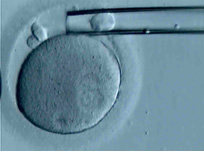
PGD is usually performed by testing single blastomeres removed from 8-cells preimplantation embryos. An alternative approach is represented by PGD on first (1PB) and second (2PB) polar bodies (PBs), which are extruded during maturation and after fertilization of oocytes, respectively.
PBs are considered extracellular material without a known biological role once they have been extruded after the first and second meiotic divisions. Because they contain the counterpart of the chromosomes present in the oocytes, PBs may be removed and tested to assess, indirectly, the genetic status of the oocyte. In women who are carriers for a genetic disease, genetic analysis of 1PB and 2PB allows the identification of oocytes that contain the maternal unaffected gene. However, only the maternal genetic contribution can be studied using this approach, PB testing cannot be used in cases of paternally derived disorders.
To date, only a few centres perform PGD on PBs to test for chromosomal or genetic abnormalities that might be passed maternally to the offspring. Verlinsky and colleagues pioneered the approach, initially on 1PB only (Verlinsky et al., 1990) and later in combination with the 2PB (Verlinsky et al., 1997), to increase the accuracy and efficiency of diagnosis because of recombination events, which occur frequently between homologous chromosomes.
Analysis of PBs might be considered an ethically preferable way to perform PGD for couples with moral objections to any micromanipulation and potential discarding of abnormal embryos (Kuliev et al., 2001; Kuliev, 2006). It may also be an acceptable alternative for countries in which genetic testing of the embryos is prohibited (Tomi et al., 2005, 2006), precluding the ethical debate concerning biopsy of human embryos. PGD has been performed for the above purposes after fertilization of oocytes, by genetic analysis of 1PB or sequential analysis of 1PB and 2PB, allowing only those that are predicted to be normal to proceed to syngamy.